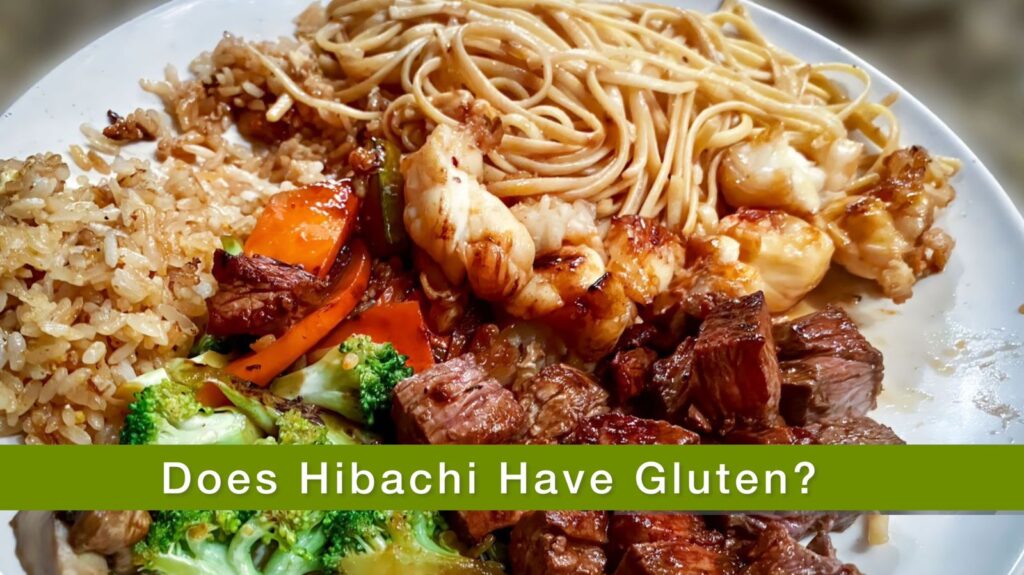
One of the most unique features of Japanese cuisine is hibachi food, which is a veritable treasure trove of delicious meals and inventive cooking methods. If you’re a food enthusiast, you may have heard about or tried Japanese hibachi cuisine in a restaurant. However, have you ever wondered does hibachi have gluten? Join me as we explore the health benefits of hibachi and discover how to prepare authentic hibachi dishes at home.
You will find its widely used recipes and preparation techniques in this article. Get ready to drool!
Does Hibachi Have Gluten?
Yes, traditional Hibachi grilling involves sauces that may have gluten in them.
The traditional Hibachi is made with meats or veggies. The issue, though, comes with sauces and particular dishes that have gluten in them. Hibachi cooking is an intricate tapestry of centuries-old customs, methods, and alluring ingredients. The chef’s skill, displayed over an open grill to transform the meal into a gourmet spectacle, is at the heart of the experience.
But as dietary preferences change around the world, many people wonder if Hibachi is suitable for gluten-free diets. It is essential to comprehend the basic ingredients of Hibachi recipes. The main ingredients of most Hibachi meals include proteins (such as chicken, beef, or shellfish), a variety of vegetables, and the distinctive sauces that give the cuisine its distinct flavor. The main course is frequently served with rice, either steamed or fried.
What is Hibachi?
In Japanese, “bachi” refers to a bowl, and “hi” denotes fire. A Hibachi is essentially a huge open bowl or a long tray that is constructed of ceramic, wood, or metal and has a circular, square, or rectangular shape. It was first produced as a heating apparatus during the Heian dynasty. Nevertheless, new advancements and needs turned it into a cooking device. These days, Hibachi is available outside of Japan as well. In American and European societies, some people mistake Hibachi for a teppan, an iron girdle used for cooking.
Hibachi chefs now grill, saute, stir-fry, pan-fry, charcoal-grill, and smoke delicious Japanese delicacies using this heating girdle. Hibachi cooking is also rapid since the device heats food evenly and to high temperatures using gas or charcoal fires. To reach high temperatures, “binchotan,” a unique type of coal, is usually employed.
Health Implications of Gluten in Hibachi
Hibachi food consumption can have negative health effects, especially for people who have gluten sensitivity or celiac disease. While many people with celiac disease may have digestive pain, exposure to gluten can cause serious immunological reactions.
Hibachi is a culinary experience with its enthralling ballet of flavors and ingredients. Yet, a certain population segment faces serious health risks due to gluten in several hibachi foods. It becomes imperative to understand the implications of consuming gluten, particularly when indulging in such delectable treats.
The protein gluten, which is present in wheat, barley, and rye, is generally not harmful to health. Nonetheless, a growing number of people have problems linked to gluten that can cause a variety of symptoms. The range of these conditions consists of:
Celiac Disease
An autoimmune condition in which eating gluten causes the body to target the lining of the small intestine. Frequent exposure causes nutritional malabsorption, which can set the stage for neurological problems, osteoporosis, infertility, and other autoimmune diseases.
Non-Celiac Gluten Sensitivity (NCGS)
When consuming gluten, those with NCGS may have symptoms such as headaches, exhaustion, and abdominal pain, which are comparable to those of celiac disease. They do not, however, test positive for wheat allergies or celiac disease.
Wheat Allergy
A wheat allergy produces an allergy-causing antibody to wheat proteins, unlike celiac disease or NCGS. The symptoms can include anaphylaxis, breathing difficulties, and hives.
When it comes to gluten, the problem with hibachi usually lies in the sauces and preparations. For example, wheat is usually present in traditional soy sauce, which is an essential component of many Hibachi recipes.
Gluten can easily make its way into foods that seem harmless if one is not attentive.
Where to Discover Gluten-Free Hibachi
It can be difficult for people following gluten-free diets because of personal preferences or medical concerns like celiac disease to find a suitable Hibachi restaurant.
Let’s talk about how to find gluten-free hibachi restaurants and guarantee a secure dining experience.
Speciality Dining Establishments
Specialized restaurants that only serve gluten-free food have become more popular as a result of the growth in gluten-related diseases. Hibachi restaurants that prioritize gluten-free options can be found in urban locations and even in some suburban areas.
To guarantee customer safety, these companies frequently put their employees through rigorous training and follow stringent ingredient procurement guidelines.

Customized Meal Requests
The majority of hibachi restaurants take great satisfaction in the versatility and skill of their cooks. Many restaurants may adjust dishes to satisfy gluten-free requirements if you let them know about your dietary restrictions when you make your reservation or when you get there.
It’s critical to address issues with marinades and sauces, as these are frequently the unseen gluten sources in hibachi cooking.
Utilize Digital Directories
Advancements in technology have led to the creation of digital platforms that support individuals with certain dietary requirements. Hibachi eateries are featured in carefully curated listings of restaurants that cater to gluten-free diners, thanks to websites and smartphone programs like Gluten-Free Registry and Celiac Restaurant Guide.
Have Hibachi at Home
If you want the highest level of certainty, the best option may be to duplicate the Hibachi experience at home. There are a tonne of expert-level recipes available on the internet that highlight items that are gluten-free.
Purchasing gluten-free sauces and condiments allows one to have a traditional Hibachi meal that is customized to meet specific dietary needs.
Engage with Professional Gluten-Free Networks
How to get the best gluten-free food? Well, Organizations such as the Gluten Intolerance Group or the Celiac Disease Foundation frequently offer tools, such as recommended restaurant lists or safe dining standards. Speaking with these experts might provide insightful information on trustworthy Hibachi restaurants.
It takes a combination of proactive research, honest communication, and sometimes home cooking experiments to pursue gluten-free Hibachi. The increasing recognition of dietary needs in the professional culinary world has made it easier and less complicated to get gluten-free Hibachi.
Creating Your Authentic Gluten-Free Hibachi Sauce
Gluten can occasionally be found in traditional hibachi sauces, especially if they contain ordinary soy sauce or certain thickening agents. Still, sticking to a gluten-free diet should motivate you to appreciate this essential aspect of the hibachi experience.
It is completely possible to make a real, gluten-free hibachi sauce; here’s how.
Gluten-Free Soy Sauce
Start with a premium soy sauce that is gluten-free. Soy sauces brewed without wheat are available from a number of reliable manufacturers; this ensures that the sauces are gluten-free while maintaining their rich, umami-packed flavor. This is what your hibachi sauce will be made of.
Depth with Ginger and Garlic
Your sauce will have more depth and zing from freshly grated ginger and minced garlic. Hibachi food is known for its authentic Asian flavors, which are enhanced by these ingredients.

Sweetness & Balance
Sake or mirin, which may contain wheat derivatives, are traditional ingredients in hibachi sauces. Rather, choose gluten-free substitutes like rice vinegar to add a hint of acidity, and counterbalance it with organic sugar or honey.
Creaminess with a Twist
If you want to make a creamy hibachi sauce similar to the well-known “yum-yum” sauce, try using mayonnaise. Make sure the brand you choose is gluten-free, or for a more homemade taste, try making your own with egg yolk, oil, and vinegar.
Final Flourish
Toasted sesame oil dashes add a nutty aroma to your sauce, while a sprinkle of green onions or chives adds a flash of freshness. For those who would rather, you may add some gluten-free spicy sauce or a dash of chili flakes to turn up the heat.
Making your own gluten-free hibachi sauce is about reclaiming an experience rather than just practicing cooking.
Making your own hibachi sauce at home with thoughtful ingredient selection and a dedication to authenticity will do more than just satisfy dietary restrictions. However, its flavor will also be strong, guaranteeing that every hibachi meal is delicious, safe, and unforgettable.
Also read the perfect Hibachi sauce recipe.
Conclusion

Hibachi dining presents a seductive fusion of savory pleasures and culinary artistry. It takes careful attention to navigate Hibachi menus for those following gluten-free diets.
One of the most important things we learned from our investigation is that Hibachi components, particularly sauces and marinades, may contain gluten.
It is critical to understand the health risks associated with gluten, especially for people who have celiac disease or gluten sensitivity.
Thankfully, there are a few ways to make gluten-free Hibachi experiences possible: specialty restaurants, customized meal orders, online directories, Hibachi projects at home, and networking with other professionals.
The confluence of gastronomy and diet consciousness in today’s culinary environment guarantees a safe and enjoyable experience for individuals who seek gluten-free Hibachi.
Also read:
Does Samosas Have Gluten? Learn Gluten-free Samosa Recipe In 6 Easy Steps
Is Chow Fun Gluten-free? (Learn Other Chinese Dishes That Are Gluten-free)







